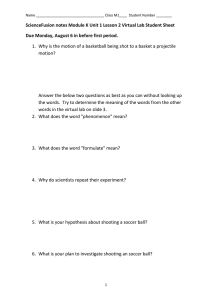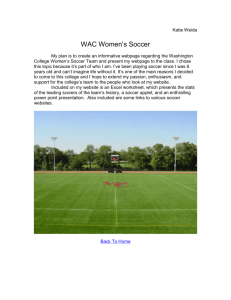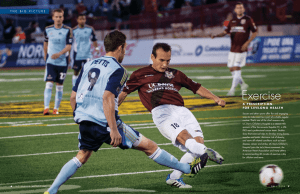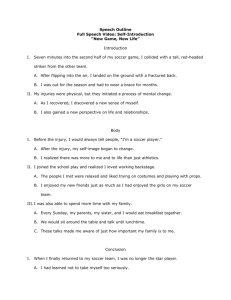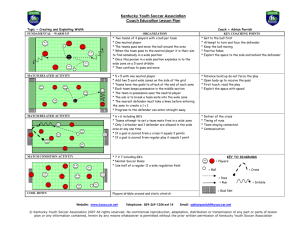Inter-layer Learning Towards Emergent Cooperative Behavior
advertisement
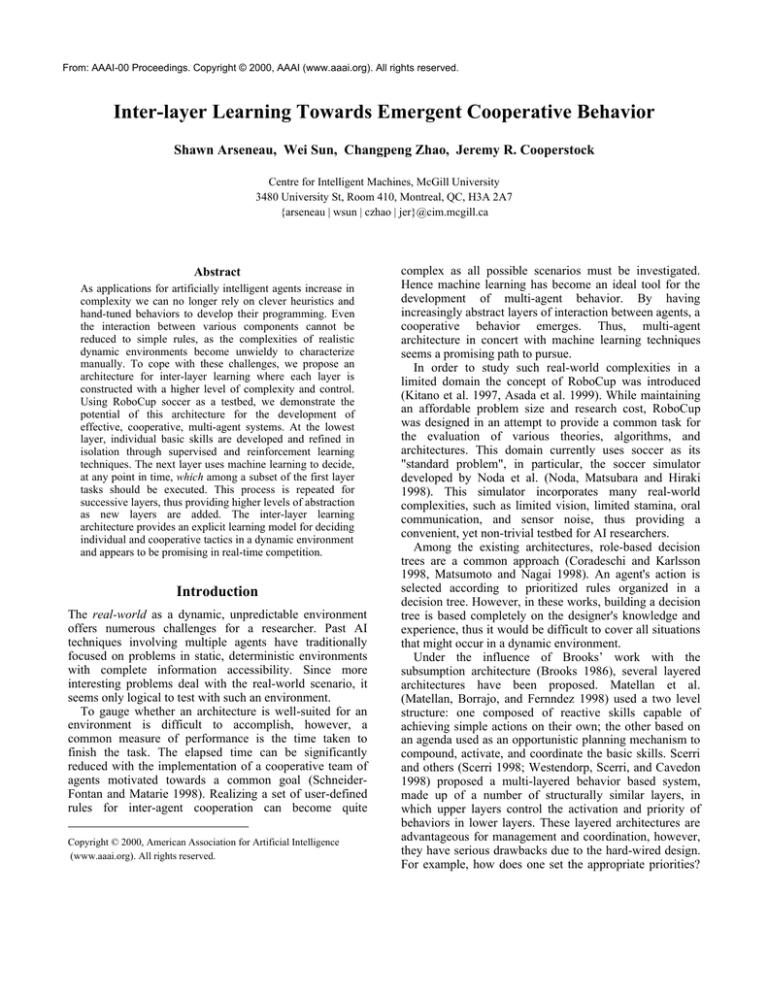
From: AAAI-00 Proceedings. Copyright © 2000, AAAI (www.aaai.org). All rights reserved.
Inter-layer Learning Towards Emergent Cooperative Behavior
Shawn Arseneau, Wei Sun, Changpeng Zhao, Jeremy R. Cooperstock
Centre for Intelligent Machines, McGill University
3480 University St, Room 410, Montreal, QC, H3A 2A7
{arseneau | wsun | czhao | jer}@cim.mcgill.ca
Abstract
As applications for artificially intelligent agents increase in
complexity we can no longer rely on clever heuristics and
hand-tuned behaviors to develop their programming. Even
the interaction between various components cannot be
reduced to simple rules, as the complexities of realistic
dynamic environments become unwieldy to characterize
manually. To cope with these challenges, we propose an
architecture for inter-layer learning where each layer is
constructed with a higher level of complexity and control.
Using RoboCup soccer as a testbed, we demonstrate the
potential of this architecture for the development of
effective, cooperative, multi-agent systems. At the lowest
layer, individual basic skills are developed and refined in
isolation through supervised and reinforcement learning
techniques. The next layer uses machine learning to decide,
at any point in time, which among a subset of the first layer
tasks should be executed. This process is repeated for
successive layers, thus providing higher levels of abstraction
as new layers are added. The inter-layer learning
architecture provides an explicit learning model for deciding
individual and cooperative tactics in a dynamic environment
and appears to be promising in real-time competition.
Introduction
The real-world as a dynamic, unpredictable environment
offers numerous challenges for a researcher. Past AI
techniques involving multiple agents have traditionally
focused on problems in static, deterministic environments
with complete information accessibility. Since more
interesting problems deal with the real-world scenario, it
seems only logical to test with such an environment.
To gauge whether an architecture is well-suited for an
environment is difficult to accomplish, however, a
common measure of performance is the time taken to
finish the task. The elapsed time can be significantly
reduced with the implementation of a cooperative team of
agents motivated towards a common goal (SchneiderFontan and Matarie 1998). Realizing a set of user-defined
rules for inter-agent cooperation can become quite
Copyright © 2000, American Association for Artificial Intelligence
(www.aaai.org). All rights reserved.
complex as all possible scenarios must be investigated.
Hence machine learning has become an ideal tool for the
development of multi-agent behavior. By having
increasingly abstract layers of interaction between agents, a
cooperative behavior emerges. Thus, multi-agent
architecture in concert with machine learning techniques
seems a promising path to pursue.
In order to study such real-world complexities in a
limited domain the concept of RoboCup was introduced
(Kitano et al. 1997, Asada et al. 1999). While maintaining
an affordable problem size and research cost, RoboCup
was designed in an attempt to provide a common task for
the evaluation of various theories, algorithms, and
architectures. This domain currently uses soccer as its
"standard problem", in particular, the soccer simulator
developed by Noda et al. (Noda, Matsubara and Hiraki
1998). This simulator incorporates many real-world
complexities, such as limited vision, limited stamina, oral
communication, and sensor noise, thus providing a
convenient, yet non-trivial testbed for AI researchers.
Among the existing architectures, role-based decision
trees are a common approach (Coradeschi and Karlsson
1998, Matsumoto and Nagai 1998). An agent's action is
selected according to prioritized rules organized in a
decision tree. However, in these works, building a decision
tree is based completely on the designer's knowledge and
experience, thus it would be difficult to cover all situations
that might occur in a dynamic environment.
Under the influence of Brooks’ work with the
subsumption architecture (Brooks 1986), several layered
architectures have been proposed. Matellan et al.
(Matellan, Borrajo, and Fernndez 1998) used a two level
structure: one composed of reactive skills capable of
achieving simple actions on their own; the other based on
an agenda used as an opportunistic planning mechanism to
compound, activate, and coordinate the basic skills. Scerri
and others (Scerri 1998; Westendorp, Scerri, and Cavedon
1998) proposed a multi-layered behavior based system,
made up of a number of structurally similar layers, in
which upper layers control the activation and priority of
behaviors in lower layers. These layered architectures are
advantageous for management and coordination, however,
they have serious drawbacks due to the hard-wired design.
For example, how does one set the appropriate priorities?
There is also the problem dealing with oscillations between
behaviors when information indicates more than one
behavior is applicable. Finally, handling uncertain
information becomes yet another challenge.
In order to cope with these problems, some effort has
been made to incorporate machine learning into the layered
structure. Noda et al. (Noda, Matsubara and Hiraki 1996)
implemented neural networks to train an agent to choose
between two basic behaviors, shooting and passing. Balch
(Balch 1998) used Q-learning to train individual behaviors
to determine when and how to activate a particular skill,
given a common set of hand-coded low-level skills. Luke
et al. (Luke et al. 1998) attempted genetic programming to
"evolve" an entire soccer team from a set of low-level
"basic" behavior functions to be used by individual agents.
These methods, however, did not fully exploit the use of
machine learning for low-level behaviors.
Stone and Veloso used neural networks to learn a basic
behavior, ball interception, which was then incorporated
via a decision tree into the learning of passing (Stone and
Veloso 1998). They further suggested an extension to
incorporate learning into the decision between dribbling,
passing, and shooting skills, though this higher level was
not implemented. In a later paper, they proposed a general
framework named “layered learning” to deal with
intractable tasks (Stone and Veloso 1999). This approach
decomposed the problem, i.e. passing the ball, into several
simpler, learnable steps: ball interception, pass evaluation,
and pass selection. While this method provided an
innovative framework for complex task decomposition, it
did not, unfortunately, provide a mechanism for the learned
selection among a set of lower-layer subtasks, such as that
suggested earlier (Stone and Veloso 1998).
As an extension of the behavior-based layered structure
(Luke et al. 1998), a generic architecture is proposed to
incorporate machine learning techniques into the decision
making process for multi-agent systems. This scheme is
applicable to both individual and team cooperation in a
dynamic environment.
the desired scale of control according to various demands
of applications. For example, considering a number of
agents as a single entity, an additional layer could be built
to attain more complex, cooperative behaviors between
these groups.
The subdivision within a specific layer is done based on
the perception of the world by the agent. For example, if an
agent is to drive a car, one could divide the actions of
parking and passing another vehicle on the highway, as
each would become a viable option only under specific
environmental conditions. The subdivisions within a layer
are based on certain environmental variables which may be
specific to that particular layer. This presents the danger of
information overload. To follow the design principle of
minimalism (Werger 1999), each layer uses only
information about the environment pertinent to itself to
simplify the entire process (Westendorp, Scerri, and
Cavedon 1998). It should also be noted that the choice of
percepts and reward functions are user defined, therefore it
is left for future work.
The inter-layer learning architecture is used to design a
team of soccer playing agents within the RoboCup
simulator (Noda et al. 1998). The soccer team employs
three distinct layers: basic skills, individual strategy, and a
team strategy (Figure 1). Supervised and reinforcement
learning are used, although unsupervised learning is also a
possible venue to explore when building the interaction
between layers. Each of these layers is discussed in further
details in the following sections.
Inter-layer Learning Approach
Figure 1. Overview of the inter-layer learning agent
architecture. Note that the branches denote choices not
inputs.
The general layout of the proposed architecture is a treelike structure, where each additional layer introduces a
higher level of complexity and control. As an example, a
three-tier structure is shown in figure 1. The team strategy
layer determines for each agent which individual strategy
is to be adopted. Based on the individual strategy, an agent
chooses an appropriate behavior from all possible basic
behaviors in the lower level. The ultimate action output of
an agent is the result of a top-down decision making
process.
Machine learning of this layered architecture is
implemented in a bottom-up fashion. Basic behaviors are
learned first. The individual strategy layer then learns to
choose between basic behaviors. Finally, the team strategy
layer learns to coordinate a group of learned agents.
This process could be continued as necessary to achieve
Basic Skills
A machine learning approach is employed to develop the
basic skills, as other RoboCup researchers have done in the
past (Stone and Veloso 1998, Ohta 1998, Tambe et al.
1998). The basic skills layer is subdivided into passing,
dribbling, shooting on the goal, anticipating a pass,
intercepting the ball, marking, and clearing. Neural
networks are chosen for three of the skills, each based on a
single action, intercept the ball, shoot on goal, and pass the
ball. As it is possible to determine whether the action is
appropriate soon after its execution, a supervised-learning
algorithm is well suited for this type of scenario.
Dribbling and anticipating a pass are learned using
temporal difference Q-learning (Q-TD) as both of these
skills involve a more complex state space and reward
function. This choice is further motivated as Q-TD is an
active reinforcement learning scheme that does not require
the estimation of a world model, i.e. the state transition
probabilities.
Both marking and clearing are analytically derived due
to the nature of the skills (Stone, Veloso, and Riley 1999).
In the following discussion, we examine in further details
the skills of dribbling (Q-TD), passing (neural network),
and anticipating a pass (Q-TD).
Dribbling – Q-TD. The task of dribbling is not only to run
with the ball towards the opponent's goal, but also to avoid
opponents. Given the delayed-reward aspect of this
scenario, Q-TD was chosen for this skill.
The learning agent is trained to dribble against an
opponent that has been trained to intercept the ball. A state
is defined by the following three variables: opponent's goal
direction, opponent's distance, and opponent's direction.
The agent decides among five dribbling directions. At the
early stage of learning, decision-based exploration is used
so that the agent chooses actions that have been picked less
often. The reward is assigned to both intermediate and
terminal states based on distance gained towards the
opponent’s goal and time consumed. The assignment of
intermediate reward motivates the agent to dribble towards
the opponent's goal, thus helping speed up the learning
procedure.
Figure 2 shows gained distance versus epochs during the
Q-TD procedure. When the maximum distance the agent is
able to reach stop increasing and the minimum distance is
constantly above a certain threshold, which is 20 in this
case, we consider that the learning is finished. Therefore,
in Figure 2, the learning ended after approximately 400
epochs.
has possession of the ball.
Passing – BPNN. The challenge of passing the ball is in
choosing the appropriate teammate to receive the pass.
Since passing is not a continuous behaviour but a single
action, for which active reinforcement learning is difficult
to set up, the back-propagation neural network (BPNN)
was chosen to learn this skill.
The passing skill is learned in a simplified environment
with a passing agent, one teammate, and one opponent.
Both the teammate and the opponent have learned to
intercept the ball through a neural network at this point.
Before learning begins, the passing agent simply passes the
ball to its teammate while the opponent tries to intercept
the ball. The agent's visual data is then used to train a BP
neural network for the passing skill.
The input values for the neural network are the
teammate’s distance and direction as well as the
opponent’s distance and direction. The neural network
converged after 292 iterations as shown in Figure 3.
Figure 3. BP neural network training procedure for
passing skill
In a real soccer competition, an agent has to choose to
pass the ball to one of m teammates in the presence of n
opponents, where m and n are arbitrary numbers. The
trained neural network discussed above can be used as
follows: First, compute the matrix S of probabilities of a
successful pass to teammate i given the position of
opponent j. Then, select teammate i* with the highest
probability of success, to receive the pass, where:
Si* = maxi minj Sij.
Figure 2. Q-TD procedure for dribble skill.
In a real soccer competition, the agent will use the
learning result, without further Q-value updating, to
dribble around the closest visible opponent. If no opponent
is visible, the agent will remember the last visible opponent
and behave accordingly. This learned dribble skill also has
the added benefit of an emergent collision detection
function as the player learns to avoid the opponents when it
This technique is similar to assigning confidence values to
each of the choices (Stone and Veloso 1998).
Random choice
Neural network
Success
254
276
Failure
75
53
Success rate
77.2%
83.9%
Table 1. Comparison of passing results by random choice
and NN learning.
For evaluation, the neural network choice was compared
to a random choice with three teammates and three
opponents in the passing agent's field of view. The results
are shown in Table 1. The successful passing rate increases
by 6.7%. While the effect is marginal, it does nevertheless
demonstrate improved performance.
Anticipating a Pass – Q-TD.The most difficult of the
basic skills to implement is how to anticipating a pass. In a
real game of soccer, a player must attempt to visualize the
field from the perspective of its teammate with possession
of the ball. In the RoboCup environment, the individual
agents have a fixed viewing arc in which they gather visual
percepts. In an attempt to learn this skill, the idea of a
viewcone (Figure 4) is introduced in order to discretize the
percepts as well as to create a simple but effective visual
model along the lines of the minimalist design approach
(Werger 1999).
Figure 4. Viewcone of labeled arcs
The player first converts all of its information about the
other players’ positions on the field into global
coordinates. These values are then converted to a relative
coordinate system with respect to the passer. Finally, a
viewcone is constructed whereby the passer parses its 90_
visual field into 15_ arcs and weights them according to
the closest player. If a teammate and an opponent appear in
the same arc, the closer of the two to the passer will
determine the weight. These weights are entered into a Q
value temporal difference learning scheme to determine the
best possible action to perform. Another value used is if
the passer has an unobstructed view of the player.
The four possible actions available to the player are to
remain still, dash forward towards the passer, turn right
and dash, or turn left and dash. In order for the player to
choose the best possible actions, a unique reward system is
devised. To encourage the player to dash to a location
where it is open for a pass, the maximum reward is granted
when the passer has an unobstructed view of the player and
has two null arcs on either side (which would appear as 0,
+1, 0 in the viewcone), in which case the player has no
immediate threat of opponents. The reward decreases as
teammates replace these null arcs, and the player is
punished for being beside opponents, out of the viewcone
of the passer, or within the passer’s viewcone but behind
another player.
After teaching the agent in a scenario with four
teammates and five opponents randomly placed on one half
of the field for over 28000 iterations, (with a state space of
5103 states), the player gradually chose an appropriate
direction. With Q-value learning in this scenario, it is
difficult to show the convergence, as the reward given after
each step may produce the best action, but still results in an
ineffective position. For example, if the player is outside
the passer’s viewcone, it may take several actions before it
can achieve an improved position and hence escape from
the low reward states. However, in comparing the learned
skill against a random behavior, the learned skill moved in
an appropriate direction approximately 70% more often.
Individual Strategy Layer
The individual strategy layer involves choosing amongst
basic skills from a higher-level viewpoint (Noda et al.
1996). This layer is subdivided into four types. The first
division dictates whether the agent has possession of the
ball (aggressive) or not (auxiliary). This is further
categorized into offensive and defensive depending on
whether the agent's home area is on its own side of the
field or its opponent's side (see Figure 1). The home area
refers to the center of a circular region in which the agent
may move. These regions are overlapped to accommodate
agent interaction. The individual strategy examined here
will be aggressive-defensive, which implies that the agent
must choose among dribbling, passing, and clearing. As
the choice to clear the ball is made analytically, when no
other course of action is possible, in this instance the
decision learning is between that of dribbling versus
passing. This is useful for both aggressive-offensive and
aggressive-defensive players.
Dribble/Pass. A learning agent is surrounded by four
teammates and four opponents. All these players have been
trained to dribble, pass, and intercept the ball. To simplify
the learning situation, the teammate will only dribble after
receiving a pass. The players pass or dribble the ball as far
as possible towards the opponent's goal until an opponent
successfully intercepts the ball.
The visual information of the learning agent is gathered
to train a back-propagation neural network. Viewcone
quantization is used here again to simplify the visual
information of the learning agent. The weighted viewcone
arc values discussed earlier as well as the direction of the
opponent’s goal are fed into the neural network.
In order to obtain the desired output of the neural
network, both decisions of dribbling and passing are tested
for the same configurations. The reward of each decision is
calculated as:
reward=(distance gained)-0.01×(time consumed)
For each configuration, the decision with the higher reward
determines the desired output of the neural network.
Figure 5 illustrates the training procedure which
converged after 15228 iterations to under 5% error. This
behavior during our actual soccer competition proved
highly effective at eluding the opposing team.
figures are then used to determine the regions
corresponding to the average position of both teams. This
approach is similar to the tolerance design technique
(Werger 1999). For example, in Figure 7, the mean of team
A (white) lies in region 2 and team B (black) in region 5.
The pseudo-variance varies with the number of agents
present in the mean region.
Figure 5. BP neural network training procedure for
Dribble vs. Pass
Team Strategy Layer
This layer of learning investigates the performance of
emergent team behavior. In order to adapt to different
opponents and different scenarios, an effective team must
learn to become more defensive or offensive during the
match (Tambe 1996). In this particular scenario, a modelbased approach to team strategy is adopted (Tambe 1996,
Tambe et al. 1998) as opposed to a strictly behavior-based
strategy (Werger 1999). This becomes the first layer of
cooperation between the agents, and can potentially be
expanded to further layers.
Three types of strategies; offensive, defensive, and
half/half, are defined by three possible sets of home areas
of the players (Figure 6).
(a)
(b)
(c)
Figure 6. Team Strategies: (a) half/half, (b) offensive,
(c) defensive
To facilitate the learning of an appropriate team strategy,
a captain agent is introduced. This individual agent would
carry the burden of deciding which team strategy to adopt
based on its own visual cues and relays its decision to the
rest of the team. In order to account for players outside the
captain’s field of view, the concept of temporal decay is
applied (Westendorp, Scerri, and Cavedon 1998).
Once the captain has received its visual information, a
world-model is created. Based on this world-model, Q-TD
is applied to learn the team strategy.
The positional percepts that define the state values must
be discretized in order to reduce the state space to a
manageable size.
To maintain useful information
regarding team positions and local densities of players, a
field mean and pseudo variance are calculated by dividing
the field into six partitions in the x-direction. These
Figure 7. Discretized field
The final piece of data used by the learning algorithm is
the ball location, which is also needed to create the
appropriate reward. The reward relies solely on the amount
the ball advanced or retreated during 100 ticks of the game
clock. The choice of this time is completely heuristic.
After learning, the captain chooses between offensive,
defensive, and half/half strategies according to the state of
the game, and broadcasts this choice to the team. Each
player picks a different home area corresponding to the
new strategy, which determines whether the player will
focus more on the opponent’s side of the field (offensive)
or on its own (defensive).
Results and Conclusions
Once all of the layers were integrated into a complete
soccer playing agent, our team was entered into the 1999
RoboCup competition at McGill University, outscoring the
competition by a total of 12:0. The inter-layer learning
architecture appears to be a reasonable structure for a
multi-agent, cooperative task. Employing the agents to
learn cooperative behaviors, as opposed to taking an
analytical approach, allowed emergent team strategies to
be adopted.
It should be noted that although the final behavior is
emergent, the human designer is still responsible for the
division of the sub-tasks as well as the choice of training
data. However, this approach extends the application of
machine learning from the acquisition of individual tasks
to the learning of the appropriate selection criteria for
choosing between them. Expanding this architecture to
cooperation between sub-teams working collectively
appears possible, and an implementation of such a
structure is left for further research.
Acknowledgements
We would like to thank Sorin Lerner for all of his help
with the RoboCup soccer server, without whom we would
never have gotten our players to see, let alone kick the ball.
References
Asada, M., Kitano, H., Noda, I., and Veloso, M. 1999.
RoboCup, Today and Tomorrow – What We have Learned.
Artificial Intelligence. 110(2):193-214.
Balch, T. 1998. Integrating Learning with Motor SchemaBased Control for a Robot Soccer Team. RoboCup-97:
Robot Soccer. World Cup I. 483-491. Berlin, Germany:
Springer-Verlag.
Brooks, R. A. 1986. A Robust Layered Control System for
a Mobile Robot. IEEE Journal of Robotics and
Automation, RA-2(1):14-23.
Coradeschi, S., and Karlsson, L. 1998. A role-based
decision-mechanism for teams of reactive and coordinating
agents. RoboCup-97: Robot Soccer. World Cup I. 99-111.
Berlin, Germany: Springer-Verlag.
Kitano, H., Asada, M., Kuniyoshi, Y., Noda, I., Osawa, E.,
and Matsubara, H. 1997. RoboCup: A Challenge Problem
of AI. AI Magazine. 18:73-85.
Luke, S., Hohn, C., Farris, J., Jackson, G., and Hendler, J.
1998. Co-evolving Soccer Softbot Team Coordination with
Genetic Porgramming. RoboCup-97: Robot Soccer. World
Cup I. 398-411. Berlin, Germany: Springer-Verlag.
Matellan, V., Borrajo, D., and Fernndez, C. 1998. Using
ABC2 in the RoboCup domain. RoboCup-97: Robot
Soccer. World Cup I. 475-482. Berlin, Germany: SpringerVerlag.
Matsumoto, A., and Nagai, H. 1998. Decision making by
the characteristics and the interaction in multi-agent
robotics soccer. RoboCup-97: Robot Soccer. World Cup I.
132-143. Berlin, Germany: Springer-Verlag.
Noda, I., Matsubara, H. and Hiraki, K. 1996. Learning
Cooperative Behavior in Multi-Agent Environment – A
Case Study of Choice of Play-plans in Soccer. Proceedings
of the 4th Pacific Rim International Conference on
Artificial Intelligence. 570-579.
Noda, I., Matsubara, H., Hiraki, K., and Frank, I. 1998.
Soccer Server: A Tool for Research on Multiagent
Systems. Applied Artificial Intelligence 12(2-3):233-250.
Ohta, M. 1998. Learning Cooperative Behaviors in
RoboCup Agents. RoboCup-97: Robot Soccer. World Cup
I. 412-419. Berlin, Germany: Springer-Verlag.
Scerri, P. 1998. A Multi-layered Behavior-Based System
for Controlling RoboCup Agents. RoboCup-97: Robot
Soccer. World Cup I. 467-474. Berlin, Germany: SpringerVerlag.
Schneider-Fontan, M. and Matarie, M. 1998. Territorial
Multi-Robot Task Division.
IEEE Transactions on
Robotics and Automation. 14(5):815-822.
Stone, P. and Veloso, M. 1998. A Layered Approach to
Learning Client Behaviors in the RoboCup Soccer Server.
Applied Artificial Intelligence 12:165-188.
Stone, P. and Veloso, M. 1999. Layered Learning.
International Joint Conference on Artificial Intelligence
Workshop on Learning About, From, and With Other
Agents.
Stone, P., Veloso, M. and Riley, P. 1999. The CMUnited98 Champion Simulator Team. RoboCup-98: Robot
Soccer. World Cup II. Berlin, Germany: Springer-Verlag.
At URL: http://www.cs.cmu.edu/afs/cs/usr/pstone/public/
papers/98springer/final-champ/final-champ.html.
Tambe, M. 1996. Tracking Dynamic Team Activity. In
Proceedings of the thirteenth Conference on Artificial
Intelligence Applications. 11:80-87. Cambridge, U.S.A.:
MIT Press.
Tambe, M., Adibi, J., Al-Onaizan, Y., Erdem, A.,
Kaminka, G., Marsella, C., and Muslea, I. 1998. Building
Agent Teams Using an Explicit Teamwork Model and
Learning. Artificial Intelligence. 110(2):215-239.
Werger, B. 1999. Cooperation Without Deliberation: A
Minimal Behavior-Based Approach to Multi-Robot Teams.
Artificial Intelligence. 110(2):293-320.
Westendorp, J., Scerri P., and Cavedon L. 1998. Strategic
Behaviour-Based Reasoning with Dynamic, Partial
Information. RoboCup-97: Robot Soccer. World Cup I.
297-308. Berlin, Germany: Springer-Verlag.

